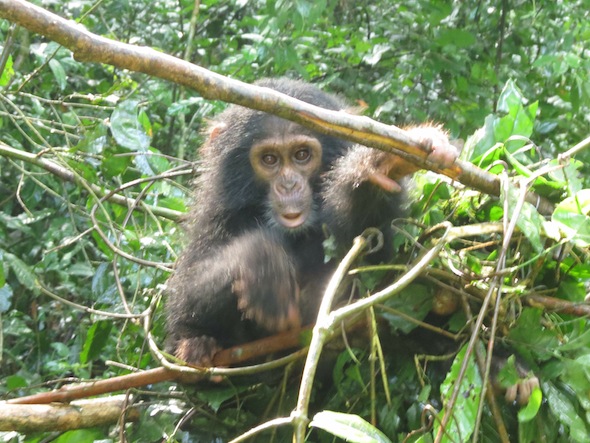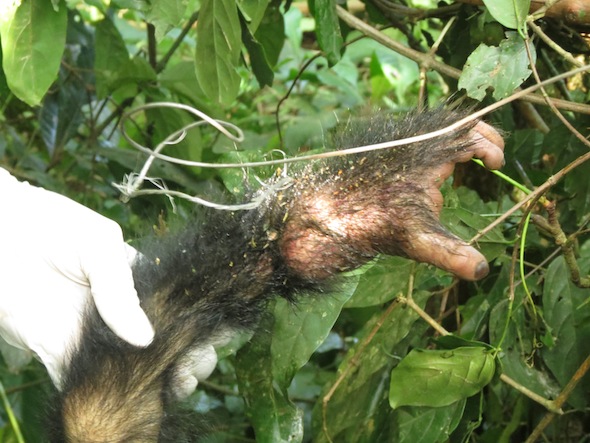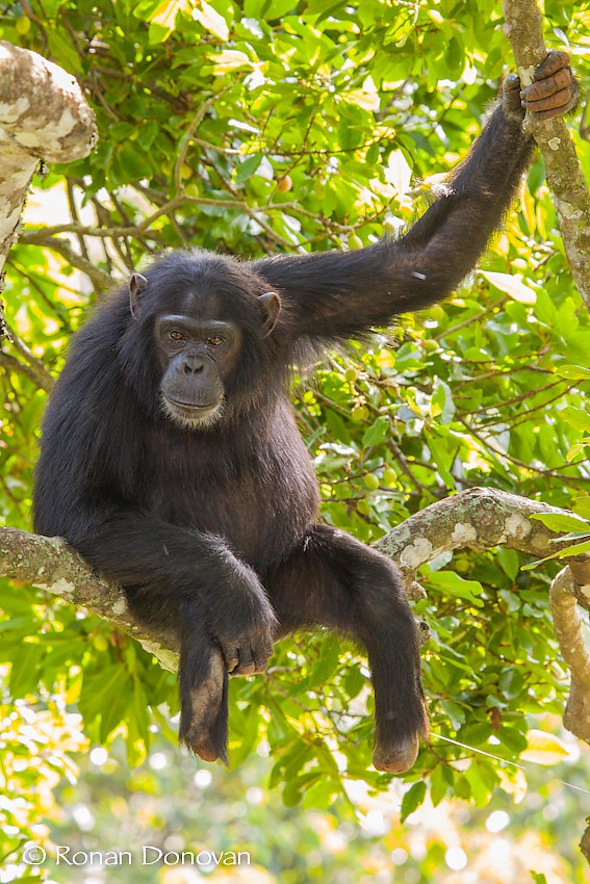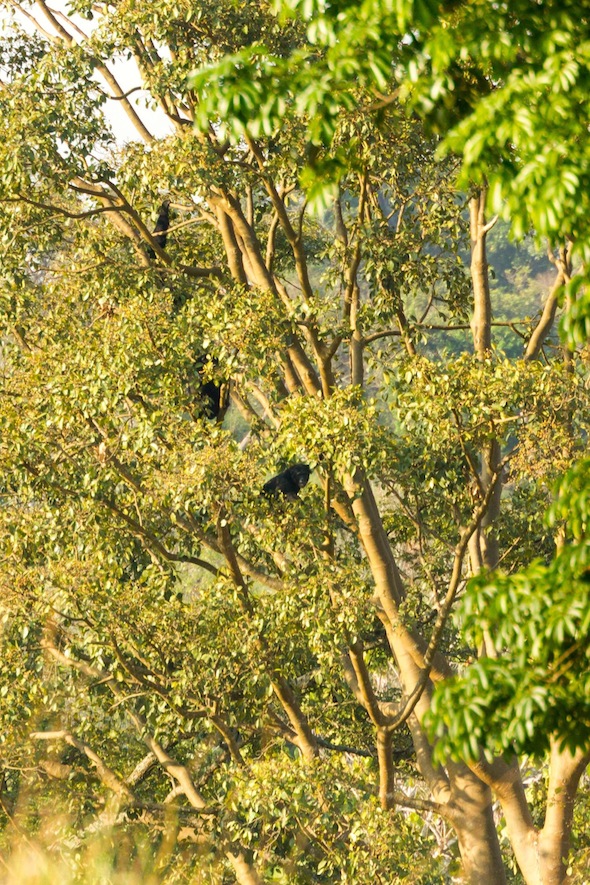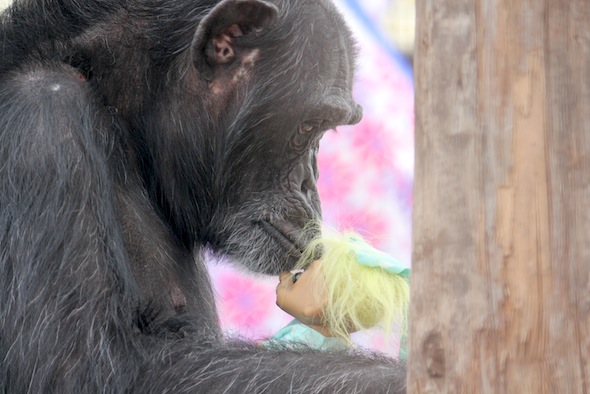Maureen McCarthy, PhD candidate at the University of Southern California, was our very first guest blogger. She is doing field research in Uganda, and while there she has been featured as a regular on Scientific American’s blog. The entry that follows is particularly moving. WARNING: some disturbing images are included in this entry.
—
This is our last week of data collection. It was supposed to be a laid-back week to collect a few more samples and enjoy a few final days tracking chimpanzees, a fieldwork victory lap of sorts. It didn’t turn out as I’d hoped, though. Instead, things went very, very wrong.
On Tuesday, we ventured back to a forest reserve south of the Budongo Forest. It’s one we’ve visited numerous times before…a much larger forest than most we visit, one which helps functionally connect the fragmented forests of this corridor region to the much larger Budongo Forest to the north. On the surface, chimpanzees here have a good habitat compared to our friends to the south in most forest fragments I’ve been studying. A closer look, however, reveals an abundance of illegal logging and snare hunting sites within the forest. Though snare hunting is illegal, it is a leading cause of injury and death among chimpanzees in Uganda. Up to one third of chimpanzees in forests of Western Uganda have sustained snare injuries (Reynolds, 2005; Wrangham and Goldberg, 1997; Wrangham and Mugume, 2000).
We received news that chimpanzees had been heard far inside the forest early that morning. Jack and I, along with a field assistant and a guide from the National Forestry Authority, began traveling through the forest en route to the area where they were heard. Around mid-morning, we too began hearing pant hoot vocalizations from the chimpanzees, as well as occasional whimpers and screams, which are not unusual, especially among larger parties. We projected waypoints for their location and followed trails in that direction until we knew we were close. It sounded like a large party was present, with a second party approximately 200 meters away.
We decided to leave the nearby party so as not to disturb them, instead backtracking along their trail in the hopes of finding nests from the previous night. After successfully locating numerous nests and dung samples, we followed their trail back to where they’d been calling in the hopes of finding that they’d gone, leaving some dung samples behind. Instead, we saw a number of chimpanzees, which, along with their earlier vocalizations, suggested a large party was still present. We watched as a subadult male climbed a tree. He produced a dung sample, and we noted its location so we could find it there after they had moved. When it seemed that the chimpanzees may be preparing to leave, we decided to slowly and carefully move closer to the tree where we saw the male, in an attempt to collect the dung. As we approached, we found that a young chimpanzee was watching us from deep within the dense vegetation. The youngster was about three years old. He watched us fearfully and whimpered from a limb about one meter off the ground, then became more fearful and began to scream. We wondered why he didn’t simply leave his leafy perch. Was he injured or trapped? One of our field assistants, who led in the front of our party, assured us confidently that he could see both hands and feet, and that all limbs were free. Despite these assurances, I was left with an uneasy feeling. However, a large party of chimpanzees was still nearby. An adult started to climb down from his position in a tree. I decided that it would be too risky to move closer through the dense vegetation. Given the thickness of the undergrowth, we would have to approach very closely to see the young chimp well enough to assess the situation thoroughly. If he then became very upset, others in the party could come to his defense and we could risk being seriously attacked. I would have to rely on my field assistant’s assessment that the youngster was fine despite what seemed to be unusual behavior. At least, we noted hopefully, there was no distressed mother visible. We left the possibility of sample collection behind and went home for the day.
The next morning, we came back in the hopes that the chimpanzees had all left and the dung samples remained. As we approached, we heard and saw no sign of chimpanzee presence. However, we soon heard the unmistakable whimpers of the same young chimpanzee. Jack and I looked at each other with sinking, awful dread. The infant chimpanzee was indeed trapped there. I approached, passing through the vegetation to get a close look at the chimpanzee. He had a wire snare around his left foot. He still seemed strong and relatively healthy despite being trapped. We suspected that he had been ensnared there sometime after the party arrived on Tuesday morning. We left the area immediately to get phone reception and called our colleagues at the Budongo Conservation Field Station for assistance. We hoped their veterinary staff could provide the necessary help to free the chimp from his snare.
The ensnared chimpanzee. Note the trapped left foot, with the snare wire visible on the branch above. Photo © Maureen McCarthy.
Phone signals were poor and transportation was challenging between Budongo and our location. We spent hours waiting but eventually received word that help was on the way. Finally, two veterinarians from Budongo met us in a nearby village. I was relieved that help had finally arrived and that this chimpanzee could be given a chance to be free again and to go on with his young life. We trekked through the forest until we finally arrived again at the location of our little friend. As we pushed through the dense vegetation, I couldn’t see the chimp at his usual post. For a brief moment, my heart leapt as I thought he may have escaped his snare. A moment later, however, I was devastated by reality—he was not visible because he had died and was now hanging below the branch where we found him earlier.
My mind was reeling. How could he have died so soon? Sure, it took hours for help to arrive, but he looked so strong earlier. Dozens of “what ifs” flooded my thoughts. What if we had ignored the risks and pushed in further yesterday to assess the situation fully and see that he was truly ensnared? What if we had stayed by his side today? What if we had just tried to release him on our own before help arrived? If we did release him, could we have helped him find the other chimpanzees in his community? I was heartbroken and guilt-ridden with thoughts that I should have done more.
Thankfully, the veterinary staff from Budongo could not have been more calming and professional. Their assessment was that the chimpanzee was likely an orphan since there was no sign of his mother in the vicinity. We should expect a chimpanzee mother to remain nearby if her infant is trapped in a snare. They also assessed the cause of the infant’s death. The infant was found hanging upside down by the trapped leg. It seems that he had fallen from the leafy cushion of branches on which he was seated and was unable to right himself. Perhaps he was simply too tired after all the trauma he’d experienced since the previous day. As he hung upside down, the oxygen-poor blood accumulated in his head as the heart was unable to pump it back up to his chest and replenish his brain with oxygen-rich blood. The wound, along with our account of where the chimpanzees traveled, corroborated the notion that the injury had occurred the previous day. Perhaps most tragically, he had only just died. If we had been able to intervene only an hour sooner, the outcome could have been very different. This particular detail is staggeringly difficult for me…
The snare injury, post-mortem. Photo © Maureen McCarthy.
The vets also assessed the reason for his injury. It was caused by what is known as a landmine snare, a particularly complex snare devised to catch a large animal such as a bushbuck. The complex construction made it clear that it would have been difficult if not impossible for the chimpanzee to free himself, at least not without losing his foot in the process. This snare was likely set by an illegal logger in one of the nearby camps within the forest, perhaps one of the men who went crashing through the forest to avoid being seen by us just earlier that morning.
The veterinarians freed the chimpanzee’s body from the snare and carefully collected it for post-mortem analysis and a respectful burial. He was so small, so vulnerable, and so beautiful. Life had only just left him, and I was simultaneously so sorry for him and so grateful that he no longer had to suffer the fear and pain he had been feeling.
What can we make of this tragedy? I feel distraught and helpless over the loss of this young innocent life. I can find comfort in a couple of thoughts, though. First, I am grateful that none of our team members was injured in what potentially could have been a very dangerous situation. If I had insisted that we push in to get a closer look when other chimps surrounded us, I could instead be writing an account of one of our team members being attacked by a chimpanzee. Second, I am grateful that, if he had to die, at least the loss of consciousness he experienced was relatively painless compared to a week or more of suffering slow starvation, a fate endured by some chimpanzees similarly caught in snares.
Max, a snare injury survivor in Kibale National Park, Uganda. Photo courtesy of Ronan Donovan.
I can take one more comfort. That is, I can hope we learn something from this awful situation and create some sort of positive outcome. I hope the plight of this innocent chimpanzee can help shed light on the gravity of snare hunting as a threat to our closest living relatives. There are committed individuals in Uganda trying to ensure that this won’t happen to another chimpanzee. For example, please consider supporting a snare removal program such as the Jane Goodall Institute Snare Removal Program or the Kibale Snare Removal Program. Here’s hoping snare hunting becomes a thing of the past.
This post was originally published at Scientific American.
Works cited:
Reynolds, V. (2005). Chimpanzees of the Budongo Forest. New York: Oxford University Press.
Wrangham, R.W., Goldberg, T. (1997). An overview of chimpanzee conservation and management strategies. In Conserving the chimpanzees of Uganda: a population and habitat viability assessment for Pan troglodytes schweinfurthii (ed. E. Edroma, N. Rosen and P.S. Miller). IUCN/SSC, Apple Valley, MN.
Wrangham, R.W., Mugume, S. (2000). Snare removal program in Kibale National Park: a preliminary report. Pan Africa News 7: 18-20.
